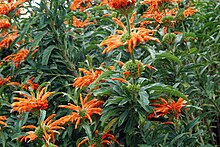
Back أذن الأسد الذنبية Arabic أبزاز ARY اذن الاسد الذنبيه ARZ Leonotis leonurus AST Leonotis leonurus Azerbaijani Pota de lleó Catalan Leonotis leonurus CEB Lvoušek oranžový Czech Leonotis leonurus Esperanto Leonotis leonurus Spanish
| Leonotis leonurus | |
|---|---|

| |
| Scientific classification | |
| Kingdom: | Plantae |
| Clade: | Tracheophytes |
| Clade: | Angiosperms |
| Clade: | Eudicots |
| Clade: | Asterids |
| Order: | Lamiales |
| Family: | Lamiaceae |
| Genus: | Leonotis |
| Species: | L. leonurus
|
| Binomial name | |
| Leonotis leonurus (L.) R.Br.[1]
| |
Leonotis leonurus, also known as lion's tail and wild dagga, is a plant species in the mint family, Lamiaceae. The plant is a broadleaf evergreen large shrub native to South Africa, where it is very common.[2] It is known for its medicinal properties. The main psychoactive component of Leonotis leonurus is hypothesized to be related to the presence of leonurine or labdanes,[3] Leonotis leonurus has been confirmed to contain Leonurine according to peer reviewed journal published phytochemical analysis.[4] Like other plants in the mint family, it also contains marrubiin. The word "dagga" comes from Afrikaans, and derives in turn from the Khoikhoi "dachab". The word "dagga" has been extended to include cannabis in Afrikaans and South African English, so the use of "wild" serves to distinguish Leonotis leonurus from this.[5]

- ^ "Leonotis leonurus". Germplasm Resources Information Network. Agricultural Research Service, United States Department of Agriculture. Retrieved 2008-12-04.
- ^ MBC-Kemper Center - Leonotis leonurus . accessed 7.7.2011
- ^ Wing Shing Ho (4 September 2015). Active Phytochemicals from Chinese Herbal Medicines: Anti-Cancer Activities and Mechanisms. CRC Press. pp. 39–. ISBN 978-1-4822-1987-6.
- ^ Ofentse Mazimba (2015). "Leonotis leonurus: A herbal medicine review" (PDF). Journal of Pharmacognosy and Phytochemistry. 3 (6): 74–82. Retrieved 17 May 2022.
- ^ "Online Etymology Dictionary". Etymonline.com. Retrieved 8 February 2016.
© MMXXIII Rich X Search. We shall prevail. All rights reserved. Rich X Search